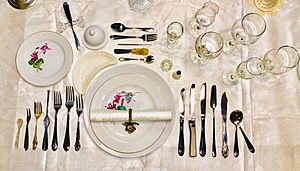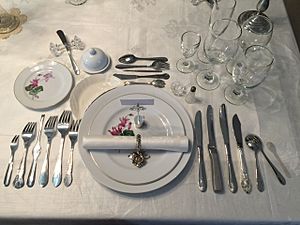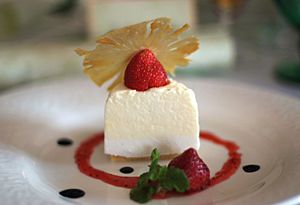Full-course dinner facts for kids

A European/American 13 course table setting
|
|
| Type | Meal |
|---|---|
| Course | At least three |
A full-course dinner is a special dinner that has many different dishes, called courses. It's not just one big plate of food! A simple full-course dinner might have three or four courses, like a first dish, a main dish, and a dessert. Some very fancy dinners can have many more courses, even up to 21! These meals are usually eaten in the evening or afternoon.
What is a Multi-Course Meal?
A multi-course meal is a meal with several different courses. Most of these meals in Western countries follow a common order, often inspired by traditional French cooking. Each course is designed to be a certain size and style that fits its place in the meal. The number and type of courses can change depending on where you are and what the local customs are.
Here's a common way a multi-course meal might go:
- Starting the Meal: It often begins with a small dish called an hors d'oeuvre or appetizer. This is usually a small bite that doesn't include red meat. In Italy, they might serve antipasto, which are small finger foods without pasta or starch.
- Light Dishes: After the appetizer, there might be other lighter dishes, like a fish course. The number and size of these dishes depend on the local traditions.
- The Main Event: Next comes the main course. This is usually the most important and largest dish of the meal.
- Salad Time: After the main course, a salad course might be served. Sometimes, this salad is actually a cooked vegetable, not just green leaves. In America, salads are often served before the main course.
- Cheese Please: The meal might continue with a cheese selection, often served with a special wine. In some places, cheese comes before the meal, but in many European countries and the U.S., it's served between the main course and dessert. In the UK, cheese usually comes after dessert.
- Sweet Ending: The meal often finishes with a dessert, which can be hot or cold. Sometimes, fresh fruit is served too, along with a special dessert wine.
These kinds of meals are usually very formal and can be quite expensive. In very formal dinners, the courses are carefully planned to taste good together. The dishes are smaller, and the meal can last for three, four, or even five hours. Often, each course (except for very light ones) is served with a different drink, like wine, beer, or a liqueur.
How Food is Served
There are different ways food can be served in a multi-course meal:
- Service à la Russe: In one modern way, called service à la russe, each course is brought to the table one after another. Guests have an empty plate, and the food is served to them, or they choose from a variety of dishes and serve themselves. In restaurants, your plate often comes to you already filled with your portion. You usually can't ask for something different or for more food.
- Service à la Française: Another way, called service à la française, is like "family-style" dining. All the courses are placed on the table at the same time. Guests serve themselves. The downside is that not all dishes stay at their perfect temperature. A buffet is a bit like this, where all the food is set out in a serving area, and guests go to get their food and bring it back to their table.
Setting the Table

Setting a table for a multi-course meal can be quite fancy! For very formal meals, all the silverware and glassware you'll need for the whole meal might be placed on the table at the start. The silverware is often laid out so that you use the tools on the outside first for the earliest dishes. So, when your first course arrives, you just pick up the fork or spoon furthest from your plate.
For example, a very fancy 13-course table setting can include many forks, knives, spoons, and glasses. There might be special spoons for caviar or bone marrow, and different forks and knives for fish, lobster, or salad. Above your plate, you might find a bread knife and plate, a small dish for fish bones, and spoons for sorbet or dessert. Many different glasses for water, champagne, and various wines will also be there.
Sometimes, only the silverware for the first one or two courses is set out. As the meal goes on and new courses arrive, the used silverware is taken away with the empty dishes, and new silverware is placed next to your plate. This is common when you order dishes "à la carte" (meaning you choose individual dishes), so the right tool can be given for each specific course you pick.
How Many Courses?
Meals can have different numbers of courses. Here are some common examples:
Single Course Meal
- Main dish only (like a typical family dinner)
Two-Course Meal
- Soup or Salad
- Main course
OR
- Main course
- Dessert
Three-Course Meal
- Appetizer
- Main course (sometimes called Entree in North America)
- Dessert
Four-Course Meal
- Soup or Bread
- Salad
- Main Course
- Dessert
Five-Course Meal
- Appetizer
- Soup
- Main course
- Dessert
- Cheese
Six-Course Meal
- Hors d'oeuvres (small snacks)
- Soup
- Fish
- Main Course
- Salad
- Coffee
- Dessert
OR
- Amuse-bouche (a tiny, single bite to prepare your palate)
- Soup
- Hors d'oeuvres
- Main course
- Salad
- Dessert
A Famous Example: The Titanic's Last Dinner
First-class passengers on the famous ocean liner RMS Titanic had an amazing eleven-course meal on the night of April 14, 1912, just before it sank. Imagine eating all of this!
First course—small bites
Second course—soups
Third course—fish
- Poached salmon with mousseline sauce (salmon cooked gently with a light, airy sauce)
Fourth course—main dishes
- Filets mignon lili (small, tender cuts of beef)
- Chicken lyonnaise (chicken cooked in a specific French style)
- Vegetable marrow farci (stuffed squash)
Fifth course—removes
- Lamb with mint sauce
- Calvados-glazed roast duckling with applesauce
- Roast sirloin of beef forestière (sirloin beef with a forest-style sauce)
- Château potatoes (small, shaped potatoes)
- Minted green pea timbales (small baked dishes of peas)
- Creamed carrots
- Boiled rice
- Parmentier and boiled new potatoes (a type of shepherd's pie and new potatoes)
Sixth course—punch or sorbet
- Punch romaine (a refreshing, icy drink)
Seventh course—roast
- Roasted squab on Wilted cress (roasted young pigeon with wilted greens)
Eighth course—salad
- Asparagus salad with champagne-saffron vinaigrette
Ninth course—cold dish
- Pâté de foie gras (a rich liver paste)
- Celery
Tenth course—sweets
- Waldorf pudding
- Peaches in chartreuse jelly
- Chocolate Painted Eclairs with French vanilla cream
- French Vanilla ice cream
Eleventh course—dessert
After dinner
- Coffee, cigars


